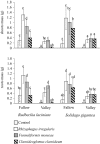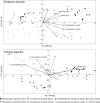The growth and phosphorus acquisition of invasive plants Rudbeckia laciniata and Solidago gigantea are enhanced by arbuscular mycorrhizal fungi
- PMID: 27581153
- PMCID: PMC5237450
- DOI: 10.1007/s00572-016-0729-9
The growth and phosphorus acquisition of invasive plants Rudbeckia laciniata and Solidago gigantea are enhanced by arbuscular mycorrhizal fungi
Abstract
While a number of recent studies have revealed that arbuscular mycorrhizal fungi (AMF) can mediate invasive plant success, the influence of these symbionts on the most successful and high-impact invaders is largely unexplored. Two perennial herbs of this category of invasive plants, Rudbeckia laciniata and Solidago gigantea (Asteraceae), were thus tested in a pot experiment to determine whether AMF influence their growth, the concentration of phosphorus in biomass, and photosynthesis. The following treatments, including three common AMF species, were prepared on soils representative of two habitats that are frequently invaded by both plants, namely fallow and river valley: (1) control-soil without AMF, (2) Rhizophagus irregularis, (3) Funneliformis mosseae, and (4) Claroideoglomus claroideum. The invaders were strongly dependent on AMF for their growth. The mycorrhizal dependency of R. laciniata was 88 and 63 % and of S. gigantea 90 and 82 % for valley and fallow soils, respectively. The fungi also increased P concentration in their biomass. However, we found different effects of the fungal species in the stimulation of plant growth and P acquisition, with R. irregularis and C. claroideum being the most and least effective symbionts, respectively. None of AMF species had an impact on the photosynthetic performance indexes of both plants. Our findings indicate that AMF have a direct effect on the early stages of R. laciniata and S. gigantea growth. The magnitude of the response of both plant species to AMF was dependent on the fungal and soil identities. Therefore, the presence of particular AMF species in a site may determine the success of their invasion.
Keywords: Arbuscular mycorrhiza (AM); Arbuscular mycorrhizal fungi (AMF); Asteraceae; Giant goldenrod; Golden glow; Plant invasions.
Conflict of interest statement
The authors declare that they have no conflict of interest.
Figures





References
-
- Błaszkowski J (2012) Glomeromycota. W. Szafer Institute of Botany, Polish Academy of Sciences, Kraków
-
- Błaszkowski J, Czerniawska B, Wubet T, Schäfer T, Buscot F, Renker C. Glomus irregulare, a new arbuscular mycorrhizal fungus in the Glomeromycota. Mycotaxon. 2008;106:247–267.
-
- Bunn RA, Ramsey PW, Lekberg Y. Do native and invasive plant differ in their interactions with arbuscular mycorrhizal fungi? A meta-analysis. J Ecol. 2015;103:1547–1556. doi: 10.1111/1365-2745.12456. - DOI
-
- Callaway RM, Thelen GC, Barth S, Ramsey PW, Gannon JE. Soil fungi alter interactions between the invader Centaurea maculosa and North American natives. Ecology. 2004;85:1062–1071. doi: 10.1890/02-0775. - DOI
MeSH terms
Substances
LinkOut - more resources
Full Text Sources
Other Literature Sources

